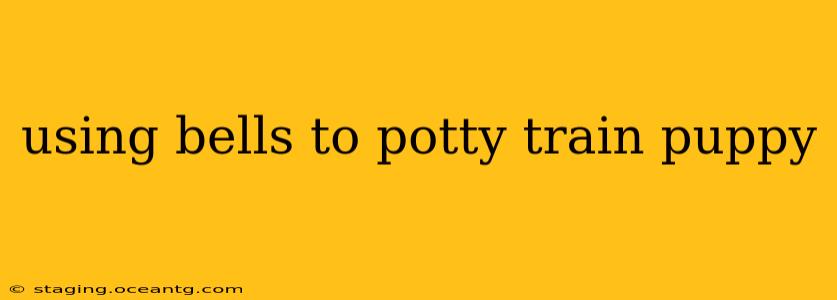Potty training a puppy can be challenging, but with patience and the right techniques, you can achieve success. One popular method gaining traction is using bells to signal potty time. This approach leverages your puppy's natural curiosity and ability to learn associations, making the training process smoother and more effective. This comprehensive guide will walk you through the process, addressing common questions and offering valuable tips for success.
How Does Bell Training Work?
The core principle behind bell training is associating the sound of a bell with the act of going potty outside. You'll hang a bell (or several bells tied together) near the door leading to your puppy's designated potty area. Initially, you'll guide your puppy to the bell and actively ring it every time they need to eliminate outside. Through repetition, your puppy learns that the bell sound means it's time for a bathroom break. Over time, they'll learn to ring the bell themselves when they need to go out.
What Type of Bells Should I Use?
The best bells for potty training are small, lightweight, and easy for your puppy to reach and ring. Consider these factors:
- Material: Stainless steel or plastic bells are durable and easy to clean.
- Sound: Opt for bells with a clear, distinct sound that's audible but not overly loud or jarring.
- Attachment: You can use bells with pre-attached ribbons or easily tie them to a sturdy surface near the door with a strong, puppy-proof string.
How to Teach Your Puppy to Use the Bells
Here's a step-by-step guide:
- Introduce the Bells: Let your puppy sniff and explore the bells without ringing them. This helps them become familiar with the new object.
- Ring the Bells: Every time you take your puppy outside to potty, ring the bells actively and clearly. Say a cue word like "potty" or "outside" as you ring the bells.
- Positive Reinforcement: When your puppy eliminates outside, reward them immediately with praise, treats, and a favorite toy. This positive reinforcement strengthens the association between the bell sound, going potty, and receiving a reward.
- Consistency is Key: Consistency is paramount in this training method. Ring the bells every single time you take your puppy outside to potty, regardless of whether they eliminate immediately or not.
- Gentle Guidance: If your puppy doesn't ring the bells themselves, gently guide their nose or paw to the bells before heading outside.
- Patience is Virtue: Some puppies catch on quickly, while others may take more time. Be patient and consistent with your training.
What if My Puppy Doesn't Ring the Bells?
It's common for puppies to not immediately grasp the concept of ringing the bells. Don't get discouraged! Continue with the steps above, emphasizing positive reinforcement and consistent guidance. You might try:
- Making the Bells More Appealing: Attach a toy or treat near the bells to entice your puppy to interact with them.
- Using Different Types of Bells: Experiment with different types of bells to find one that your puppy finds more engaging.
- Breaking it Down: Instead of immediately expecting your puppy to ring the bell independently, start by rewarding them for simply touching the bell with their nose. Gradually work your way up to ringing the bells.
How Long Does Bell Training Take?
The duration of bell training varies greatly from puppy to puppy. Some puppies may learn within a few days, while others may take several weeks or even months. Consistency and patience are essential for success.
What are the Benefits of Bell Training?
- Increased Independence: Bell training empowers your puppy to communicate their need to go outside, reducing accidents and increasing their independence.
- Reduced Accidents: By promptly alerting you to their need to go, bell training significantly minimizes accidents inside your home.
- Positive Training Method: This method relies on positive reinforcement, building a positive association with potty training and strengthening your bond with your puppy.
- Early Potty Training: Bell training can help with early potty training for puppies.
Can I Combine Bell Training with Other Potty Training Methods?
Absolutely! Bell training is highly effective when combined with other potty training methods, such as crate training, frequent potty breaks, and positive reinforcement. It complements other methods rather than replacing them.
My Puppy is Ringing the Bells But Still Having Accidents. What Should I Do?
If your puppy is ringing the bells but still having accidents, it could be due to several reasons:
- Medical Issues: Consult your veterinarian to rule out any underlying medical conditions that might be contributing to frequent urination or defecation.
- Inconsistent Training: Ensure you are consistently following the training steps and rewarding your puppy appropriately.
- Not Enough Potty Breaks: Increase the frequency of potty breaks, especially after waking up, eating, and playing.
By following this guide and practicing patience, you can successfully teach your puppy to use bells for potty training, making the process easier and more enjoyable for both you and your furry friend. Remember, consistency and positive reinforcement are key!
